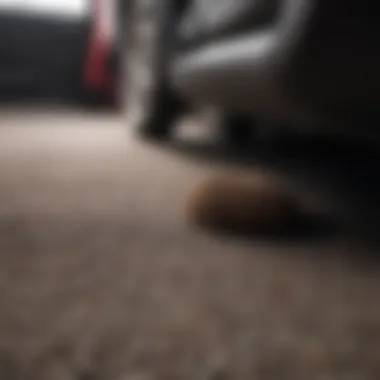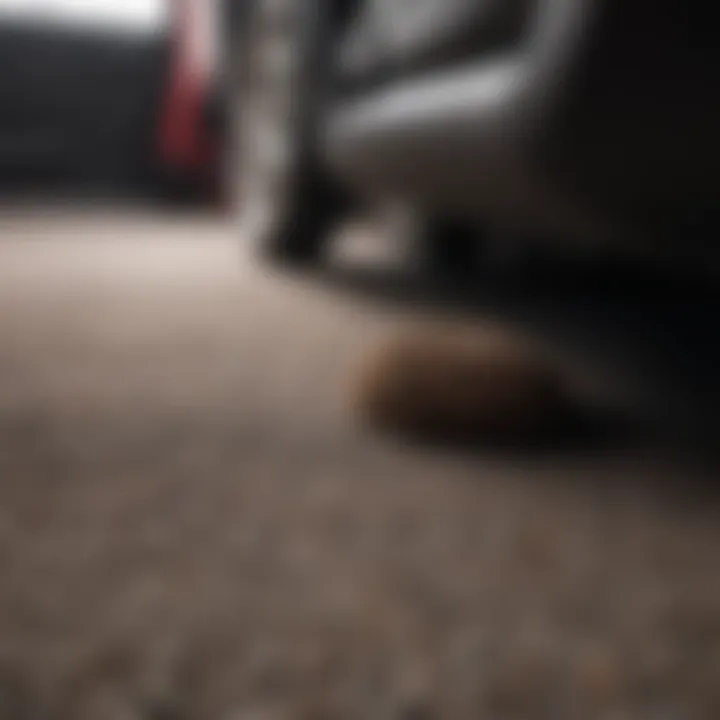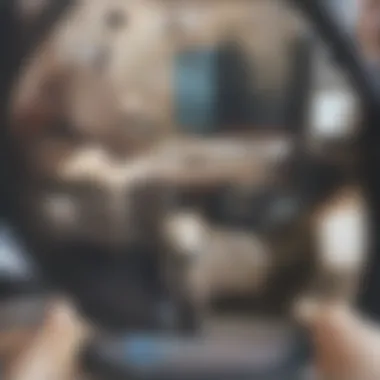Effective Strategies for Removing Dog Hair from Car Carpet


Intro
Dog ownership brings joy, but it also presents challenges, particularly when it comes to maintaining a clean car. Dog hair can accumulate quickly in car carpets, making your vehicle look unkempt. Fortunately, there are effective strategies for removing this hair, to help keep your car tidy. This article delves into practical methods and tools that can assist in this endeavor.
By understanding the various approaches available, pet owners can find the most effective techniques suited to their needs. Each method will be evaluated based on effectiveness and ease of use, ensuring that readers can find a strategy that aligns with their lifestyle.
A cleaner vehicle not only looks better but also enhances the overall driving experience. Let's explore these strategies in detail.
Intro to the Challenge of Dog Hair
Removing dog hair from car carpets can be a cumbersome task. The presence of pet hair not only affects the aesthetic appeal of the vehicle but also impacts hygiene and overall comfort. Especially for dog owners, the struggle with shedding fur is a common challenge. It is important to recognize that dog hair has unique properties that can make its removal particularly tricky.
Understanding Dog Hair Characteristics
Dog hair is generally categorized into two main types: guard hairs and undercoat hairs. Guard hairs are longer and coarser, while undercoat hairs are shorter and finer, often creating a dense layer against the dog’s skin. This undercoat, particularly in seasonal shedding periods, can result in an overwhelming amount of fur being deposited in the car. This characteristic makes dog hair more likely to become embedded in fabric surfaces, like car carpets. Additionally, the texture of car carpeting can contribute to the difficulty in removal, as the fibers tend to trap the hair tightly.
Impact of Dog Hair on Car Interior
The accumulation of dog hair in a car can lead to several issues. Firstly, it contributes to dust and allergens in a confined space, potentially affecting the health of passengers, especially those with allergies. The hair can also hold odors, which can permeate the vehicle over time, creating an unpleasant atmosphere. Furthermore, an unkempt interior may lead to a decrease in your vehicle’s resale value. Keeping the car tidy goes beyond appearance; it encompasses comfort and investment protection.
"A clean car interior reflects on the owner’s image, suggesting care and responsibility."
For those who frequently transport pets, understanding these factors can motivate proactive cleaning strategies. Ignoring the presence of dog hair may lead to more bacterial growth and greater effort needed to restore the car later. This makes it crucial for pet owners to adopt effective techniques for regular maintenance.
Assessment of Cleaning Needs
When it comes to removing dog hair from car carpets, evaluating your cleaning needs is essential. This section provides insights into two specific areas: the type of carpet in your car and how often you transport your dog. Both factors significantly influence the cleaning process and the strategies required for effective hair removal. Understanding these elements can lead to more efficient cleaning and less frustration.
Evaluating Carpet Type
The material of your car's carpet plays a critical role in how dog hair adheres to it. Different fabrics have varying textures, which can either trap hair or allow it to be removed more easily. Common materials include nylon, polyester, and wool.
- Nylon: This is popular for car interiors due to its durability. Dog hair tends to embed deeply, which makes vacuuming less effective. A more aggressive approach, such as using a rubber glove or a pet hair brush, may be necessary.
- Polyester: This material is often smoother, which means hair does not stick as much. Regular vacuuming may suffice, along with lint rollers for touch-ups.
- Wool: Natural fibers can attract and hold onto hair. Usually, a combination of vacuuming and brushing helps in maintaining the carpet’s cleanliness.
Each carpet type has its demands. Evaluating it allows you to prescribe the right tools and practices to keep your car hair-free.
Frequency of Dog Transport
Another factor that dictates your cleaning strategy is the frequency with which you transport your dog. A systematic approach is beneficial depending on how often your furry friend travels with you.
- Daily Transport: If your dog spends a significant amount of time in the car, a strict cleaning schedule is necessary. Regular vacuuming and grooming prior to travel can reduce hair build-up.
- Occasional Passenger: For dogs that occasionally join you for rides, less frequent cleaning might be adequate. However, quick clean-up methods, like lint rollers, should always be on hand for unexpected furry encounters.
- Best Practices:
- Establish a Routine: Determine a cleaning schedule based on how often you travel with your pet.
- Assess Hair Accumulation: After each trip, quickly evaluate the carpet for hair.
Understanding the interaction between your dog’s travel frequency and the type of carpet you have allows you to customize your cleaning approach. By being meticulous in this assessment, you can ensure that your car remains free from unwanted pet hair.


Tools for Removing Dog Hair
Removing dog hair from car carpets can be a daunting task. However, the right tools can make this process smoother and more efficient. Various tools are designed specifically for tackling pet hair, each offering unique benefits. Understanding these tools and their applications can greatly enhance the overall effectiveness of your cleaning efforts. Investing in suitable tools can save time and ensure a cleaner and more welcoming car interior.
Vacuum Cleaners
Vacuum cleaners are essential for removing dog hair from car carpets. They offer a powerful method of suction that can reach deep into carpets, effectively lifting hair particles that may be trapped. However, not all vacuum cleaners perform equally well when it comes to tackling pet hair. Here, we will explore vacuum cleaner attachments and their significance in achieving optimal cleaning results.
Types of Vacuum Attachments
When it comes to types of vacuum attachments, there are several options to consider. These can include:
- Pet hair tools: These specialized attachments are designed to effectively gather stubborn hair.
- Crevice tools: Ideal for reaching tight spaces in car interiors.
- Wide nozzles: Perfect for covering larger areas rapidly.
Each attachment has its unique characteristics that contribute to overall cleaning effectiveness. For example, pet hair tools often feature rubber bristles that attract hair through static electricity. This characteristic makes them a popular choice, improving the chances of a thorough clean. Conversely, while crevice tools may not collect hair as efficiently, they are invaluable for detailed cleaning, ensuring no area goes untouched during the process.
Choosing the Right Vacuum
Selecting the proper vacuum for dog hair removal is fundamental. Certain vacuums may be more effective depending on features such as power, design, and capacity. Canister vacuums hold strong suction and can easily navigate tight corners in cars. Additionally, corded vs. cordless options also influence user convenience.
The unique feature of cordless options is their portability. This portability makes them beneficial for quick clean-ups. However, their limitations in battery life can be a disadvantage during extended cleaning sessions. Hence, it is vital to consider what suits your cleaning habits best.
Lint Rollers
Lint rollers are another effective tool for dog hair removal. They are simple to use, with adhesive sheets that pick up hair effectively. Lint rollers are particularly useful for quick touch-ups but may require frequent replacement sheets. While they may not replace more robust cleaning methods, they can serve as a convenient complement.
Rubber Gloves
Rubber gloves can be an unexpected yet effective tool in the fight against dog hair. When you wear them and run your hands over the carpet, the friction helps gather dog hair toward the surface. This method is economical, as most people already own a pair of rubber gloves. However, it may require some physical effort and is best paired with other cleaning methods to achieve optimal results.
Pet Hair Removal Brushes
Pet hair removal brushes are designed specifically for this task. They typically feature bristles that grip hair without damaging carpets. Their compact size allows easy handling, making them suitable for detailed areas where vacuums struggle. One significant advantage is their reusability; they don’t require replacement like lint rollers. However, they may not perform as effectively on large areas and are best for precision cleaning.
Using the right tools significantly enhances your ability to combat dog hair. Understanding each tool's benefits and limitations allows you to approach the cleaning process effectively. With the proper equipment, maintaining a fur-free environment in your car becomes a manageable task.
Step-by-Step Cleaning Process
The process of removing dog hair from car carpets is not just about aesthetics. It impacts hygiene, comfort, and the longevity of your vehicle's interior. A systematic approach can make this task more manageable and effective. In this section, we outline the essential steps to thoroughly clean your car, ensuring it remains a pleasant space for all passengers.
Preparation of the Car
Emptying the Vehicle of Items
Before you start cleaning, taking out all items from the car is crucial. This includes personal belongings, trash, and any pet-related items. The key characteristic of this step is creating an uncluttered area where you can see and access all carpets effectively. It's beneficial because it allows for a thorough cleaning without obstacles.
Emptying the car also helps to identify where the hair accumulates the most. For instance, under seats or in storage compartments. However, it can be time-consuming if you have many items in your car. Setting aside time for this can lead to a more efficient cleaning process.


Assessing Areas of Heavy Hair Accumulation
Once the car is empty, inspect the carpets carefully. Spotting areas where dog hair tends to gather is vital. These spots are often near the seats, around the footwells, or in the trunk. Knowing the areas of heavy hair accumulation can inform your cleaning strategy.
This approach is beneficial because it helps you prioritize where to put your effort first. You can use a flashlight to see better in dimly lit parts of your car. Additionally, being methodical about these areas can ensure you do not miss critical spots during cleaning. This may take some extra moments, but it greatly enhances overall effectiveness.
Initial Hair Removal Techniques
Using the Vacuum Cleaner
Vacuuming is one of the most efficient ways to remove dog hair from car carpets. A vacuum cleaner with a powerful suction and appropriate attachments can tackle stubborn pet hair effectively. The main advantage of using a vacuum is its speed. You can cover large areas in a relatively short time.
Choosing a vacuum with a specialized pet hair attachment is particularly beneficial. These attachments are designed to pick up hair more effectively than standard tools. However, some vacuums might not reach every corner, so you may need additional techniques to ensure a complete clean.
Applying Lint Rollers
Lint rollers are a simple, practical tool that can significantly aid in the removal of dog hair. They work by utilizing sticky sheets that lift hair off the carpet. One key characteristic of lint rollers is their ease of use; they are lightweight and portable, allowing you to clean hard-to-reach places easily.
The advantages of lint rollers include their affordability and ability to quickly remove hair, especially in tight spots. They can, however, become inefficient if the sheets are full. Regularly replacing the sheets can help maintain their effectiveness.
Deep Cleaning Options
Using Rubber Gloves
Rubber gloves are a unique method for dog hair removal that can prove remarkably effective. The static electricity generated from rubbing your gloved hands over the carpet can help collect dog hair. This approach is simple and requires no special equipment. It is advantageous as it is cost-effective and good for small, targeted areas.
However, this method might not be the most efficient for larger areas. The effort needed may also be substantial, especially if there is heavy hair accumulation.
Utilizing a Pet Hair Removal Brush
A pet hair removal brush is a specialized tool designed to gather pet hair from car fabrics efficiently. Brushes specifically designed for this task can be more effective than standard brushes due to their texture and bristle design. One of the unique features of these brushes is their ability to reach deeper into the fibers of the carpet.
This method is popular because it can be very effective on both carpets and upholstery. It allows for more control over the cleaning process. While it requires some physical effort, it can be quite rewarding, resulting in a fur-free environment.
Preventive Measures
Preventive measures play a vital role in managing dog hair in your car. By taking proactive steps, you can significantly reduce the accumulation of hair, making it easier to maintain a clean vehicle. This section explores two effective strategies: regular grooming of pets and the use of car seat covers.
Regular Grooming of Pets
Grooming your dog on a consistent basis is one of the most effective ways to minimize shedding. Regular brushing removes loose fur before it has a chance to settle in your car. It is recommended to use a brush suitable for your dog's coat type, whether it is short, medium, or long.
Moreover, the grooming routine can be a bonding experience between you and your pet. This not only keeps your car cleaner but also prevents excessive fur from accumulating on your dog. Some breeds are naturally more prone to shedding, so adjusting the frequency of grooming based on your dog’s needs is essential.
- Choose the Right Tools: Invest in high-quality brushes or grooming mitts that are specially designed to trap and collect hair.
- Schedule Regular Grooming: Establish a regular schedule for grooming sessions to mitigate the sudden influx of hair. This can be weekly or biweekly.
- Consider Seasonal Shedding: Be more vigilant during shedding seasons, typically spring and fall, when dogs may shed more fur.


Use of Car Seat Covers
Car seat covers represent an effective barrier against pet hair. Utilizing these covers not only protects your vehicle's upholstery but also simplifies cleanup. By having a designated cover, you can simply remove it, shake it out, and wash it as needed.
When selecting a car seat cover, consider factors such as material, fit, and ease of cleaning. Look for waterproof options if your pet is prone to spills or accidents.
- Select Durable Materials: Choose fabrics designed for easy hair removal, such as nylon or polyester. These materials usually allow for easier cleanup with a vacuum or lint roller.
- Ensure a Good Fit: Make sure the seat cover fits your car’s seats properly to avoid sliding and continuous exposure of the fabric underneath.
- Maintain Cleanliness: Wash the cover regularly based on how much your pet travels with you. This keeps both your car and your dog more hygienic.
Preventive measures can drastically reduce the amount of hair in your car. Simple actions like grooming can lead to a cleaner vehicle and a happier pet.
By employing these preventive strategies, you can significantly mitigate the challenges posed by dog hair in your car, fostering a more pleasant driving environment.
Alternative Methods and Tips
Removing dog hair from car carpets can be a challenging task. Traditional methods can sometimes fall short, especially when the hair becomes embedded deeply in the fibers. Thus, exploring alternative approaches can be both beneficial and effective. This section elaborates on two such methods: using household adhesives and employing steam cleaners. Each method has its own merits and can be adapted based on individual needs and preferences.
Using Household Adhesives
Household adhesives, such as tape, can be surprisingly effective for removing dog hair from car carpets. The stickiness of the tape allows it to grip onto the hairs and pull them up from the carpet fibers. This is a straightforward process and requires no special equipment.
To use tape effectively:
- Select a strong adhesive tape. Duct tape or packing tape works well. Be sure the roll is large enough for you to handle comfortably.
- Cut a length of tape, usually around 12 to 18 inches.
- Press the sticky side against the carpet, firmly applying pressure. As you lift the tape, dog hairs should come with it.
- Repeat as necessary. You may need to use several strips, especially in high-traffic areas where the build-up of pet hair may be significant.
This method is particularly excellent for spot cleaning. It is quick and doesn’t require you to haul out larger cleaning equipment. However, it may not be effective for larger surface areas or heavily soiled carpets.
"Sticky solutions can sometimes yield surprisingly good results when conventional methods fail."
Using Steam Cleaners
Steam cleaners present a more thorough approach to tackling embedded dog hair. The steam loosens the hair from the carpet fibers, making it much easier to remove afterward. Employing this method does require access to a steam cleaner, which can be rented or purchased.
To utilize a steam cleaner:
- Prepare the car by removing loose items and concentrating on areas where hair collects.
- Fill the steam cleaner with water according to the manufacturer’s guidelines and allow it to heat up.
- Direct the steam at the carpet slowly. Be cautious not to over-saturate the area, as excessive moisture can cause mold if not dried promptly.
- Use a vacuum or a lint roller immediately after steaming. This takes advantage of the hair being loose, capturing it efficiently.
This method not only helps in removing dog hair but also sanitizes the carpet. It’s particularly useful for those with allergies or sensitivities to pet dander. However, it does require time and effort, along with the investment in a good steam cleaner.
Culmination and Summary
Recap of Effective Techniques
Throughout our discussion, several key methods have emerged as effective in the battle against dog hair:
- Vacuum Cleaners: Utilizing vacuums with specialized attachments can significantly enhance hair pickup.
- Lint Rollers: A quick and handy way to remove hair from surfaces of carpets.
- Rubber Gloves: The friction created by rubber can easily lift hair from carpets.
- Pet Hair Removal Brushes: These are designed specifically for this task and can be very effective, especially for deeper cleans.
Additional innovative approaches include using household adhesives and steam cleaners. Each method is unique in practicality and effectiveness, giving vehicle owners a range of options to choose from.
Final Recommendations
To ensure a consistently tidy car interior, regular grooming of pets is the best preventative measure. When your pet is well-groomed, less hair is likely to end up in your vehicle. Furthermore, using car seat covers can significantly reduce hair accumulation on carpets, making cleaning easier. It is also advisable to perform routine cleanings rather than waiting for hair to build up. A proactive approach will save time and create a more pleasant driving experience.
In summary, maintaining a car free of dog hair requires a combination of strategies and regular care. By implementing the techniques discussed, vehicle owners can create a manageable routine that addresses this common issue.



